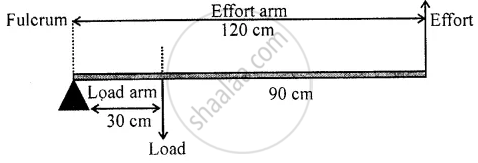Advertisements
Advertisements
Question
In a lever, the fulcrum is at one end at a distance of 30 cm from the load and effort is at the other end at a distance of 90 cm from the load. Find :
(a) the length of load arm,
(b) the length of effort arm, and
(c) the mechanical advantage of the lever.
Solution

Given,
(a) Load arm = 30 cm
(b) Effort arm = (90 + 30) cm = 120 cm
(c) Mechanical advantage = `"Effort arm"/"Load arm"`
= `"120 cm"/"30 cm"`
= 4
APPEARS IN
RELATED QUESTIONS
Fill in the blank:
In class II levers, the load is in between fulcrum and .........
What is a lever?
Give one example of a class I lever in a case where the mechanical advantage is equal to 1?
Name the class to which the following lever belong:
a lemon squeezer
Name the class to which the following lever belong:
a beam balance
Name the class to which the following lever belong:
a wheelbarrow
Name the class to which the following lever belong:
a crowbar
Draw diagram to illustrate the position of fulcrum, load, and effort, of the following:
a nutcracker
Name the machine to which the following belong:
Beam balance
Answer the following in short.
What is the basis of the classification of levers?
